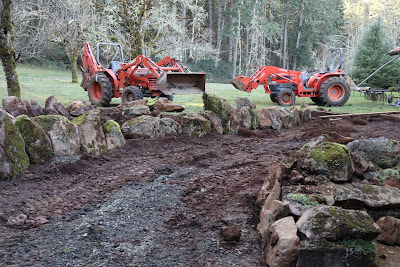Years ago I created a rock garden up a 4' tall embankment between the house and the rock-house. It turned out really beautiful as well as functional. Somehow in the 20 some years since it's completion, I never took a picture of it that I can now find.
In 2015 we had a party for Dave's retirement/birthday. The retaining wall is over our shoulders. It contained several huge boulders and ornamental herbs which unfortunately do not show in this one-and-only picture I could find.
The lawn started at the top of the retaining wall.
Water and Mud - Lots of Mud - Phase
The cement contractor, Wayne, had a different idea when he first looked at the project. "Walkway? Why not a driveway!?" Sure, why not? I removed all the plants and boulders from the retaining wall. Wayne came and laid out a rough outline of the drive. The digging began.Knowing it might be some time before we got water restored, I turned on the tub faucet to fill the tub (so we could have water to flush) as I went to the pump house to completely turn off the water. In the meantime the house plumbing filled with back-flow mud. I came back to find that Jake had had a blast tracking around in the tub mud.
All of the toilets and faucets exploded with mud filled air pockets for a few days.
In the end it made little difference to the floors in the house. Three weeks of myself and three dogs constantly walking through mud and tramping around the house just added to the general patina of the old wood floors.
The next step was removing the cement base of the retaining wall. To everyone's surprise and total amazement, the cement saw cut into a 3", cast iron, under pressure, water pipe creating a spectacular fountain higher than the second-story roof and again flooding the work area.
No one in the family had a clue about the origin of this pipe; why it exists and; why it was laid under a cement stem wall, set of cement stairs and the patio itself. We still don't know which way the water was flowing but it was stopped at the well-pump. Once again the house plumbing was filled with air and mud. Fixing the pipe proved to be quite a challenge and all work had to stop until the ground dried.
After a few days we could start to move in boulders I had stashed over the years in my landscaping boulder bone-pile. (BrownStone Chinooks does come from all of the brown stones I have mined in the woods and landscaped with.) We still could not drive equipment on the excavated area but did put down some gravel to keep from sinking too far in as we maneuvered the heavy rocks.
Not wanting to damage or scratch moss off the boulders, all were slung and carried by the excavator. (My job was getting the slings under the boulders and then removing them at the other end using a lot of muscle and the heavy steel "pig-sticker".)
Once we accumulated several in the drive area, we were able to start of the fun puzzle-piece placement of the new retaining walls. Both Wayne and I are dyslexic. Poor Matt was learning to use his new excavator and not only had to figure out the finer points of placing dangling boulders, he had to deal with Wayne and I debating "the-other-left".
As it turned out, each boulder was placed and replaced several times as we decided the best side and fit. The first two boulders took an entire day to set. Top. bottom. front, back and all other edges were up for debate on each boulder.
Once the most aesthetic option was decided upon, holes had to be dug by hand for the final placement.
Boulders were moved and placed with the excavator, tractors, hand cart and often pure muscle...

and after a few weeks, resulting in a, I can shamelessly brag, pretty spectacular retaining wall. I also did all of the placement of the boulders and rocks on the "inner" island retaining wall.

 Next: the Gravel Phase.
Next: the Gravel Phase.





















.jpg)




